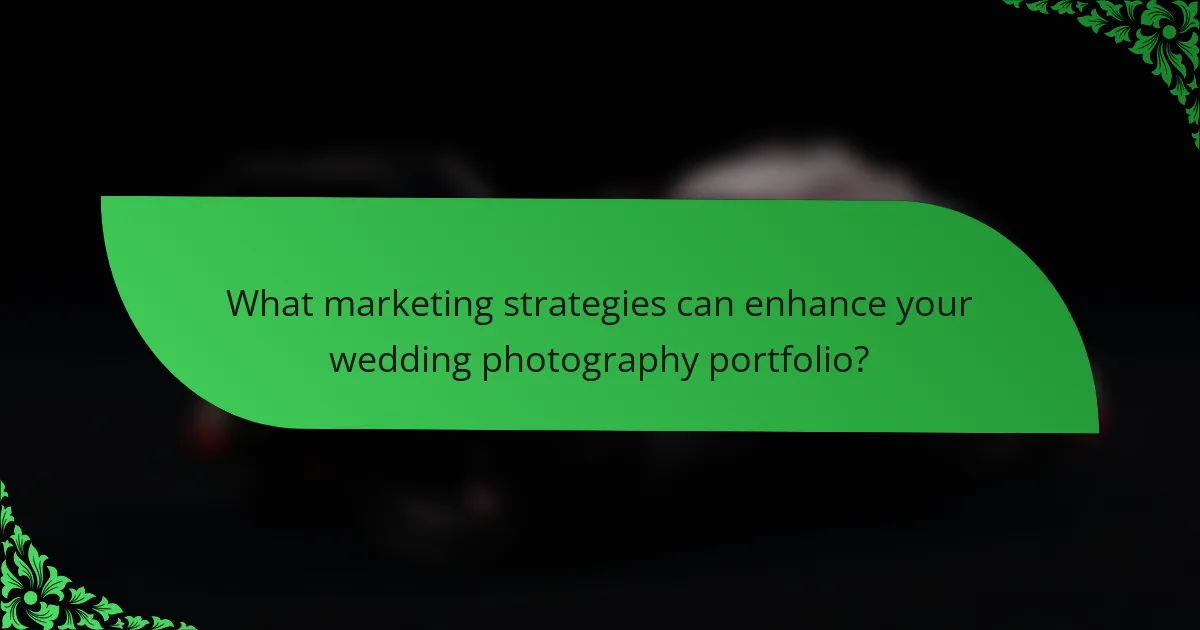Building a wedding photography portfolio involves several essential elements, including variety, storytelling, technical skill, and presentation. A successful portfolio showcases diverse high-quality images that reflect different wedding moments, such as ceremonies and candid interactions, while also demonstrating the photographer’s expertise in lighting and composition. Effective presentation ensures a cohesive layout that aligns with the photographer’s style, enhancing the overall impact. Additionally, utilizing online platforms and social media for marketing, along with incorporating client testimonials and maintaining an organized portfolio, are crucial strategies for attracting potential clients and establishing credibility in the wedding photography industry. Regular updates to the portfolio will keep it relevant and aligned with current trends.

What are the essential elements of a wedding photography portfolio?
A wedding photography portfolio should include a diverse range of high-quality images. Essential elements are variety, storytelling, technical skill, and presentation. Variety showcases different aspects of weddings, such as ceremonies, receptions, and candid moments. Storytelling captures the emotional journey of the day, highlighting key moments. Technical skill demonstrates proficiency in lighting, composition, and editing. Presentation involves a cohesive layout that reflects the photographer’s style. These elements collectively convey the photographer’s ability to capture weddings effectively.
How do you choose the right images for your portfolio?
To choose the right images for your portfolio, focus on showcasing your best work. Select images that highlight your unique style and strengths as a photographer. Ensure a variety of shots, including portraits, details, and candid moments. Aim for a cohesive look that aligns with your brand identity. Limit the number of images to avoid overwhelming viewers; around 15-20 high-quality images is ideal. Regularly update your portfolio to reflect your current skills and trends in wedding photography. Analyze feedback from clients and peers to refine your selection process.
What types of wedding photography styles should be represented?
The types of wedding photography styles that should be represented include traditional, documentary, fine art, and portraiture. Traditional wedding photography captures posed moments and key events. Documentary style focuses on candid shots that tell a story. Fine art photography emphasizes artistic composition and creative expression. Portraiture highlights individual and group portraits with attention to detail. Each style offers unique perspectives and appeals to different client preferences. Representing a variety of styles showcases versatility and attracts a broader audience.
How many images are ideal for a balanced portfolio?
A balanced wedding photography portfolio ideally contains 20 to 30 images. This range allows photographers to showcase a variety of styles and moments. A selection of 20 to 30 images provides enough diversity without overwhelming potential clients. It ensures representation of different aspects of a wedding day, including candid moments, details, and portraits. This number is commonly recommended by industry experts. A study by the Wedding Photojournalist Association suggests that portfolios with this number of images attract more client interest.
What role does storytelling play in a wedding photography portfolio?
Storytelling is crucial in a wedding photography portfolio. It creates an emotional connection with viewers. A well-crafted narrative showcases the couple’s journey. It highlights significant moments throughout the wedding day. Storytelling allows photographers to present images cohesively. This approach enhances the overall viewing experience. Engaging stories can differentiate a photographer from competitors. By illustrating unique moments, it attracts potential clients.
How can you showcase the narrative of a wedding day?
To showcase the narrative of a wedding day, capture key moments throughout the event. Start with the preparation phase, including details like the dress and venue. Document emotional moments, such as the first look and vows. Include candid shots of guests enjoying the celebration. Highlight significant traditions and rituals, showcasing their cultural relevance. Use storytelling techniques in editing, such as chronological sequencing. This approach creates a cohesive visual story. Research indicates that storytelling in photography increases viewer engagement by 60%.
What techniques enhance storytelling in photography?
Techniques that enhance storytelling in photography include composition, lighting, and emotion capture. Composition guides the viewer’s eye and establishes context. Techniques like the rule of thirds can create balance and interest. Lighting sets the mood and highlights key elements. Natural light often conveys warmth and intimacy in wedding photography. Capturing emotion is crucial for storytelling. Genuine moments between couples evoke connection and narrative. Using details, such as rings or venue decor, adds depth to the story. Sequence and timing are vital for creating a cohesive narrative. These techniques collectively create compelling visual stories that resonate with viewers.

How should you present your wedding photography portfolio?
Present your wedding photography portfolio through a well-organized and visually appealing format. Use high-quality images that showcase your best work. Include a variety of styles and moments, such as candid shots and posed portraits. Ensure the images are cohesive in style to reflect your unique vision.
Create an online portfolio using a professional website or a photography platform. This allows for easy access and sharing with potential clients. Organize your portfolio into categories, such as different wedding themes or venues. Provide brief descriptions for each section to give context to your work.
Additionally, include client testimonials to build credibility. Highlight your experience and any awards or recognitions received in the industry. Keep the layout clean and user-friendly, ensuring that navigation is intuitive. Regularly update your portfolio to reflect your latest work and trends in wedding photography.
What formats are best for displaying your portfolio?
The best formats for displaying your portfolio are digital and print. Digital formats include websites, social media platforms, and online galleries. They allow for easy sharing and accessibility. Print formats encompass physical albums, brochures, and framed prints. Print formats provide a tangible experience for clients. Each format showcases your work effectively. Research indicates that 75% of clients prefer digital portfolios for convenience. However, 60% still appreciate the tactile nature of print. Thus, a combination of both formats maximizes reach and impact.
How do online portfolios differ from physical portfolios?
Online portfolios differ from physical portfolios primarily in accessibility and presentation. Online portfolios can be accessed from anywhere with an internet connection. They allow for easy sharing through links and social media. Physical portfolios are limited to in-person viewings. They require physical space for storage and transportation. Online portfolios can include multimedia elements like videos and animations. Physical portfolios are restricted to static images and printed materials. Additionally, online portfolios can be updated frequently and instantly. Physical portfolios require reprinting for any updates or changes.
What design elements enhance the presentation of your work?
Visual hierarchy enhances the presentation of your work. It organizes elements to guide the viewer’s eye effectively. This can be achieved through size, color, and placement. Contrast also plays a crucial role. It highlights important features and creates visual interest. Consistent typography ensures readability and professionalism. White space helps to avoid clutter and focuses attention. Lastly, cohesive color schemes unify the overall look, reinforcing brand identity. These design elements collectively create a polished and engaging portfolio presentation.
How can you create an engaging client experience with your portfolio?
To create an engaging client experience with your portfolio, focus on visual storytelling. Use high-quality images that showcase your best work. Select a cohesive theme that reflects your style and brand identity. Organize the portfolio logically, grouping similar projects together. Include client testimonials to build trust and credibility. Offer behind-the-scenes insights to create a personal connection. Ensure the portfolio is easily navigable and mobile-friendly. Data shows that 75% of users judge a company’s credibility based on their website design.
What interactive features can be included in an online portfolio?
Interactive features that can be included in an online portfolio are image sliders, video backgrounds, and contact forms. Image sliders allow users to view multiple images in a single space, enhancing visual engagement. Video backgrounds can create a dynamic atmosphere, capturing attention immediately. Contact forms facilitate easy communication between potential clients and the photographer. Additionally, social media integration enables sharing of portfolio content, increasing reach. Interactive maps can showcase locations of past weddings, providing context. Testimonials sections can enhance credibility, allowing visitors to read client feedback. These features collectively improve user experience and encourage interaction.
How important is the organization of images in your portfolio?
The organization of images in a portfolio is crucial for effective presentation. A well-organized portfolio enhances the viewer’s experience. It allows potential clients to navigate easily and find relevant work. Studies show that organized portfolios lead to higher engagement rates. For example, a survey by the Creative Market indicated that 70% of clients favor portfolios that are easy to browse. This organization reflects professionalism and attention to detail. It also helps in showcasing a photographer’s style and range. Overall, proper image organization is key to attracting and retaining clients.

What marketing strategies can enhance your wedding photography portfolio?
Utilizing social media platforms is a key marketing strategy to enhance a wedding photography portfolio. Platforms like Instagram and Pinterest allow photographers to showcase their work visually. Engaging with potential clients through posts and stories can increase visibility. Collaborating with wedding planners and vendors can also expand reach. Offering promotional packages can attract new clients. Creating a professional website with an easy-to-navigate portfolio is essential. SEO optimization of the website can improve search engine rankings. Collecting and displaying client testimonials builds credibility and trust.
How do you effectively use social media to market your portfolio?
To effectively use social media to market your portfolio, focus on showcasing your best work consistently. Create visually appealing posts that highlight your photography skills. Utilize platforms like Instagram and Pinterest, which are image-centric. Engage with your audience by responding to comments and messages promptly. Use relevant hashtags to increase visibility and reach potential clients. Collaborate with other wedding vendors to cross-promote each other’s work. Share behind-the-scenes content to give followers insight into your process. According to a survey by The Knot, 90% of couples use social media for wedding planning, emphasizing its importance in reaching your target audience.
What platforms are most effective for wedding photographers?
Social media platforms are most effective for wedding photographers. Instagram is particularly popular for showcasing visual content. Its focus on images makes it ideal for photographers to display their work. Facebook allows for community building and sharing of albums. Pinterest serves as a source of inspiration and drives traffic to websites. Websites and blogs also play a crucial role in presenting portfolios in a professional manner. These platforms enable photographers to reach potential clients directly. Studies show that 80% of couples use social media to find wedding vendors. This statistic highlights the importance of a strong online presence for wedding photographers.
How can hashtags and engagement increase visibility?
Hashtags and engagement increase visibility by categorizing content and fostering interaction. Hashtags help users discover relevant posts by linking them to specific topics. For instance, using popular wedding-related hashtags can attract couples searching for photography inspiration. Engagement, such as likes and comments, boosts a post’s ranking in algorithms. Higher engagement signals quality content, leading to more visibility in feeds. Research shows that posts with at least one hashtag can increase engagement by 12.6% on Instagram (Source: HubSpot, 2021). Thus, combining effective hashtags with active engagement strategies enhances overall visibility.
What role do networking and collaborations play in marketing?
Networking and collaborations play a crucial role in marketing by expanding reach and enhancing credibility. They allow businesses to connect with potential clients and partners. Effective networking builds relationships that can lead to referrals. Collaborations can combine resources and expertise for mutual benefit. For example, a wedding photographer may partner with a venue to cross-promote services. This strategy increases visibility and access to new audiences. According to a study by the Content Marketing Institute, 70% of marketers found partnerships effective for brand awareness.
How can partnerships with vendors enhance your portfolio’s reach?
Partnerships with vendors can significantly enhance your portfolio’s reach. Collaborating with vendors like florists, venues, and caterers expands your network. These partnerships often lead to referrals, increasing your visibility to potential clients. For example, a florist may recommend your photography services to couples booking their wedding. Additionally, showcasing your work in vendor marketing materials can attract new clients. According to a study by WeddingWire, 70% of couples hire vendors based on recommendations from others. Thus, strategic partnerships can create a mutually beneficial relationship that amplifies your portfolio’s exposure.
What strategies can you use for referrals and word-of-mouth marketing?
Utilizing referral programs is an effective strategy for word-of-mouth marketing. These programs incentivize existing clients to refer new customers. Offering discounts or freebies for successful referrals encourages participation. Creating a memorable client experience also promotes organic word-of-mouth. Satisfied clients are more likely to share their positive experiences. Engaging with clients on social media fosters community and encourages sharing. Hosting events or workshops can enhance visibility and generate referrals. Research indicates that 83% of consumers trust recommendations from friends and family. This underscores the importance of leveraging personal networks in marketing strategies.
What are some practical tips for building a successful wedding photography portfolio?
To build a successful wedding photography portfolio, focus on showcasing your best work. Include a variety of shots, such as candid moments, portraits, and details. Aim for a cohesive style that reflects your unique vision. Select images that highlight your technical skills and storytelling ability. Keep the portfolio updated with recent work to demonstrate growth. Use high-quality prints or a well-designed website for presentation. Engage with potential clients through social media to increase visibility. Networking with other vendors can also lead to referrals and collaborations.
The main entity of the article is the wedding photography portfolio. It covers essential elements such as variety, storytelling, technical skill, and presentation, which are crucial for effectively showcasing a photographer’s work. The article also outlines how to select the right images, represent different photography styles, and maintain a balanced portfolio with 20 to 30 images. Additionally, it discusses the importance of storytelling in capturing the emotional journey of the wedding day, effective presentation techniques, and marketing strategies, including the use of social media and vendor collaborations, to enhance visibility and attract potential clients.



